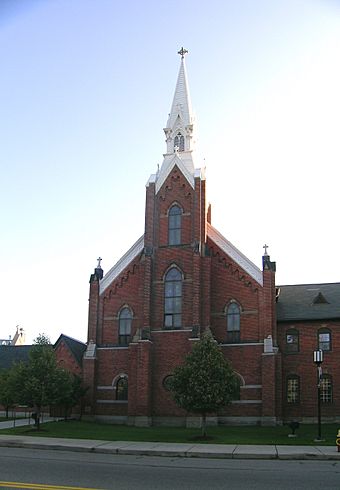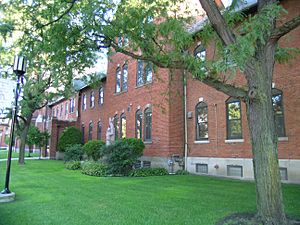St. Bonaventure Monastery facts for kids
Quick facts for kids |
|
|
St. Bonaventure Monastery
|
|
 |
|
| Location | Detroit, Michigan |
|---|---|
| Built | 1883 |
| Architect | Peter Dederichs Jr. |
| Architectural style | Gothic Revival |
| NRHP reference No. | 82000554 |
| Added to NRHP | December 02, 1982 |
The St. Bonaventure Monastery is a group of religious buildings in Detroit, Michigan. It was built for the Order of Friars Minor Capuchin, also known as the Capuchin friars. This important place is located at 1740 Mt. Elliott Avenue. It was added to the National Register of Historic Places in 1982, which means it's a special historical site.
Contents
St. Bonaventure Monastery was started in 1882. It was one of many Roman Catholic places built in Detroit during the late 1800s. The Capuchin friars asked the Bishop of Detroit, Caspar Borgess, if they could start a community there.
The bishop suggested they could help as chaplains at the Mount Elliott Cemetery. He also said they could build a monastery in the city. The friars agreed and got permission to begin their work. In 1882, they moved into a small house near the cemetery. The next year, the monastery across the street was ready for them to move in.
How the Monastery Helped the Community
The monastery was first meant to serve Catholic priests and churches. But it also gave emergency help to people who were poor. During the Great Depression, the monastery became a major source of help. It provided relief for many poor workers on the East Side of Detroit.
By 1931, the monastery's Capuchin Soup Kitchen was very busy. It was giving out as many as 3,500 free meals every day. This shows how much they cared for and supported their community.
Father Solanus Casey: A Special Friar
The monastery is also important because of its connection to Blessed Solanus Casey. Father Solanus was a Capuchin friar. He worked as the monastery's porter from 1924 to 1946. A porter is someone who greets visitors at the door of a friary.
Father Solanus also helped at the Soup Kitchen. He comforted people who were hungry. He was very important in getting food and supplies for the kitchen during the Great Depression.
Father Solanus's Path to Sainthood
In 1966, Father Solanus Casey was suggested as a candidate for sainthood. On July 8, 1987, his body was moved. It was found to be incorrupt, meaning it had not decayed. His body was dressed in a new religious habit. Then, it was placed in a steel casket.
He was re-buried under the north transept at St. Bonaventure's. People still offer prayers there, asking for Father Solanus's help. Father Solanus was beatified in Detroit on November 18, 2017. Beatification is an important step toward becoming a saint.
St. Bonaventure Monastery has three main buildings. The first is the monastery itself, built in 1883 and finished in 1913. It has a Gothic-influenced design. The second building is the Soup Kitchen, built in 1908. The third is the Third Order Hall, built in 1939.
All three buildings are made of red brick. They sit on a foundation of hand-cut limestone. They also have a lot of limestone decoration. The monastery area also includes a small cemetery. There is also a mission building that was built in 1960.


